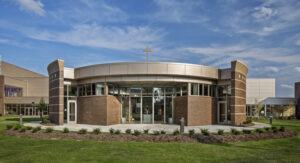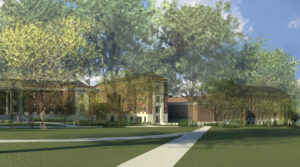Case Studies
North Catholic High School – Cranberry Twp.
PROJECT DESCRIPTION: A 185,000 SF private high school built in Cranberry Twp, PA. This ground up structure is a steel structure, brick and metal panel façade with windows. The total building cost was $50 M and it was delivered with a Hybrid Integrated Project Delivery System with a Lump Sum Contract.

MAJOR IMPETUS FOR HIGHER LEVELS OF COLLABORATION:
* Cost Control * Better Coordination * BIM * Value Engineering * Team Building * Claim Avoidance * Maximum Safety
KEY PLAYERS: OWNER: Diocese of Pittsburgh; ARCHITECT: Astorino; GENERAL CONTRACTOR: Mascaro Construction; MAJOR SUBCONTRACTORS: Cost Company, Lighthouse Electric and Renick Brothers.
PROJECT TEAM SELECTION CRITERION: BIM Experience & Cooperative with other firms
CULTURE AMONGST TEAM: Cooperative * Soulful * Flexible * Team Oriented
EARLY INVOLVEMENT OF PROJECT TEAM MEMBERS: A major reason why this project was successful was due to Mascaro’s early involvement with BIM, Value Engineering, Schedule Solutions, and Logistics.
TECHNIQUES THAT ALLOWED TEAM TO OPERATE COLLABORATIVELY: Prayer * Unique Team Building Exercises * “Rocks in the Road” Analysis (A Mascaro Construction pre-construction team building activity to address potential project issues) * Demand for Respect at All Levels & at All Times
RESOURCES THAT ENHANCED COLLABORATION: BIM * Navisworks * Newforma Project Management
QUANTIFIABLE PROJECT OUTCOMES: No Lost Time due to Accidents * Met Budget * Met Schedule * LEED Silver Certification * Six Student Workshops
LESSSONS LEARNED FROM THIS PROJECT: We would have benefitted from a more coordinated set of documents.
THOUGHTS FROM THE OWNER: “Collaboration requires solid leadership and the assembly of the right team members. Choosing the right team is essential.” Michael Arnold, Catholic Diocese of Pittsburgh
Revised December, 1974
Approved November, 1971
Cleveland Clinic Lutheran Hospital Emergency Department

PROJECT DESCRIPTION: A 29,000 SF renovation and expansion of a hospital emergency department in Cleveland, OH. The building that the ED occupies was built in 1957. The new emergency department will increase by 30% to 21 beds and 30,000 patients a year. With a primary focus on behavioral health patients, safety of patients, and giving care are first priority. Construction is scheduled for 22 months and eight (8) phases. The total building cost is $12,900,000 and the project was delivered under an Owner Controlled Team Project Delivery (OCTPD).
MAJOR IMPETUS FOR HIGHER LEVELS OF COLLABORATION: With the rising cost of healthcare and the increase in demand for patient services, the Emergency Department needed to be upgraded to continue operation. Two previously completed projects had cost overruns of 46% on average and schedule delays. The Hospital could not accept this level of risk on this size project.
KEY PLAYERS: OWNER: Cleveland Clinic; ARCHITECT: Bostwick Design Partnership; CONSTRUCTION MANAGER: The Krill Company
PROJECT TEAM SELECTION CRITERION: The Architect was selected on a proposal basis. The Owner and Architect selected the Construction Manager early in Schematic Design. Selection was based on a request for proposal and the interview. Together, the Owner, Architect, and CM selected Design- Assist trades during Design Development. Design-Assist trades included: electrical engineering, mechanical engineering, interiors, and fire protection. All Design-Assist trades were required to bid the job. The fire protection Design-Assist trade did not complete construction.
CULTURE AMONGST TEAM: The culture among the team is one of respect. Respect for each other and the Hospital grounds they are working within. The CM and Subcontractors have direct relationships with the Architect. Throughout the course of the project, surveys were completed to gauge the level of teamwork. Surveys included questions related to trust, respect, and cooperation. The team consistently scored 4.5 out of 5, with 5 being the highest.
EARLY INVOLVEMENT OF PROJECT TEAM MEMBERS: This project team experienced an unprecedented level of commitment and engagement. The Owner and Architect selected the CM during Schematic Design. Design-Assist trades were selected early in Design Development. This engagement reduced the Owner’s risk to typical project budget and schedule creep. On this project, the budget set at Schematic Design is holding through construction. The entire team is actively engaged during both design and construction, increasing their understanding of the project. Throughout the course of the project, the team has improved their productivity, ultimately resulting in net savings to the job.
TECHNIQUES THAT ALLOWED TEAM TO OPERATE COLLABORATELY:
- OCTPD is an Owner led delivery method. The Owner was a key stakeholder representative at all design and construction meetings. The facilities department coordinated with the design and construction teams with regards to the existing facility.
- A Project Coach was hired to facilitate a Team Development process. This process allowed the team to create a common mission and project specific goals. The team created unique action plans to achieve project goals. Together they monitored progress and remained focused on the aforementioned project-specific goals during construction.
- Multi-discipline task teams were deployed to track progress on goals and solve specific problems as necessary. This task team approach created the opportunity for the appropriate team member to be involved in the solution. Additionally, it added to the complete transparency of the project status by all entities involved in the project team.
RESOURCES THAT ENHANCED COLLABORATION:
- BIM was used as a communication tool. Models and details were shared during design. Existing conditions were modeled and the BIM model was used to proactively work through field conditions, identify conflicts, and share knowledge.
- Old-fashioned, standard conversations were used. Every key team member had headquarters within ten miles of the job site. The team capitalized on this proximity during design and construction as face-to-face meetings were held with little advanced noticed, often to get to an immediate solution or to keep team members informed of progress.
QUANTIFIABLE PROJECT OUTCOMES:
- The project budget established at the conclusion of Schematic Design has held through 70% completion of construction. The team does not see that this will change.
- 96% of the construction contingency remains unused.
- Changes during construction have resulted in a savings (give back) to the project budget.
- Rework due to unforeseen conditions has been less than $5,000. This is unprecedented for renovating a 1957 building.
- Patient satisfaction scores have increased during construction.
- There have been no recordable safety infractions through 70% construction completion.
LESSONS LEARNED FROM THIS PROJECT: The project had four major goals: maintain patient/staff/team satisfaction, manage the budget and schedule, keep leadership engaged and informed, and make decisions with the entire hospital in mind. The key lessons learned for each are as follows:
- Maintain Patient/Staff/Team Satisfaction: When working within an existing hospital, it is critical to keep the patients and staff informed on the impact of the construction project. To do this, we notified staff verbally during their hospital daily safety huddles, and we sent out weekly newsletters highlighting the upcoming work and noise level. These two things allowed the caregivers to not be surprised by the level of activity. The team made an improvement by allowing for more time for staff to move into space before opening. We made an adjustment to the schedule Phases 2-5 after Phase 1 opening resulted in frustrated staff.
- Manage Budget and Schedule: The key to this was two-fold: full transparency and compartmentalizing budget and schedule into small manageable parts. Our team focused on eliminating rework from unknown conditions and Owner changes. To manage unforeseen conditions, the Architect partnered with Design-Assist trades to complete an invasive existing conditions review. This investigation during design, coupled with using BIM, allowed the team to effectively manage existing conditions. One lesson learned was to model all existing conditions. The team made a decision to not include an area in the model during design, this area proved to be the most difficult to build. Building a visually effective design model which accurately represented the clinical spaces allowed the Owner to understand their new working conditions. Reviewing 3D design with the clinical team, once again, just before construction, proved to be beneficial to both budget and schedule.
- Keep Leadership Engaged and Informed: The construction team developed a customized monthly reporting system that detailed the budget and schedule, highlighting specific goals; such as: contingency spent, rework, changes, and RFIs. This consistent and transparent report allowed leadership to make informed project decisions. The leadership team from all project partners were are engaged in regular jobsite rounding sessions as a result. These sessions mirrored clinical rounds by physicians and allowed the team to gauge the status of the project. Rounding occurred every two weeks during the twenty-two month project.
- “Make Decisions With The Entire Building In Mind”: The construction team was able to coordinate critical shutdowns and temporary heating/cooling without impacting patient care. Additionally, the construction team was able to stop and rework their schedule without impact to the project schedule or budget when exterior work impacted and caused vibration of the operating room.
AIA-MBA Joint Committee Contact Information:
Eric Starkowicz, Director of Industry Relations, Master Builders’ Association of Western PA
Phone: 412.922.3912 Email: estarkowicz@mbawpa.org
Revised November, 1993
Approved January, 1967
PSU Henderson Project Phase 2: Health & Development Building

PROJECT DESCRIPTION: The Health & Human Development Building is the second phase of a two-phase, Pennsylvania Department of General Services-funded project for the College of Health & Human Development. This project consisted of 105,505 SF of new construction and 39,147 SF of renovation construction and the total building cost is $43,500,000 for this project on Penn State University Main Campus. This project is delivered as a Design-Bid-Build multiple prime delivery method.
MAJOR IMPETUS FOR HIGHER LEVELS OF COLLABORATION: Penn State’s Office of Physical Plant selected this project as one of several pilot projects to test process innovations in an effort to create higher-performing and more predictable construction delivery outcomes. The two-phase Henderson project also presented a unique opportunity to explore the benefits of facilitated collaboration, as many members of both the design and construction teams continued on from the initial phase, which was delivered in the traditional manner.
KEY PLAYERS: OWNER: The Pennsylvania State University; ARCHITECT: Bohlin-Cywinski Jackson; CONSTRUCTION MANAGER (Agency CM): Massaro Corporation
PROJECT TEAM SELECTION CRITERION: The Architect and Construction Manager were pre-selected. Design-Assist from trade contractors was limited due to contractual limitations by the funding source (DGS). Under these limitations it was not permissible to directly engage trade contractors in advance of the open public bid process. Massaro engaged three non-bidding, Design-Assist trade contractors for limited scope.
CULTURE AMONGST TEAM: The team was generally engaged and positive, with communications being typically quite candid. Everyone constantly communicated face-to-face. Regular 360 Team Surveys indicate high marks for respect, teamwork, cooperation and other leading indicators of high-performance.
EARLY INVOLVEMENT OF PROJECT TEAM MEMBERS: Penn State, the Architect and CM participated in a number of Design Development workshops centered on collaboration and process improvement. After establishing a common project purpose statement and achieving consensus on key performance indicators, the focus turned to basic job processes. The goal was to improve results in a direct and measurable way over the Phase 1 project. Key innovations were made in managing safety, cost control, issues, RFIs, and submittals.
TECHNIQUES THAT ALLOWED TEAM TO OPERATE COLLABORATELY:
- BIM coordination during design and construction – essential for building common understanding, identifying and resolving conflicts, and reducing rework.
- Sharing space in the “Big Room” – broke down typical barriers to engagement and communication.
- Collaborative pull planning from the field – empowered the trades to “own” the schedule as a team.
- Mobile Project Management Information Systems – facilitating improved monitoring, as well as streamlining issue tracking and resolution.
- Personal commitment to collaborate and excel – with strong leadership from Penn State and expressed in tens of thousands of individuals and group interactions over the course of the project.
- Design team had a constant jobsite presence.
RESOURCES THAT ENHANCED COLLABORATION:
- Prolog by Meridian Systems for Project Management Information System including Cost Control.
- Revit/Navisworks/360/Glue by Autodesk for BIM development and coordination.
- BIM 360 Field by Autodesk for mobile field data and document management.
- Revu by Bluebeam for processing electronic documents and submittals.
- The “Big Room” established on site as all parties were required to collocate in this shared working environment.
- Pull Planning to work with whiteboards to develop and make visible the schedule.
QUANTIFIABLE PROJECT OUTCOMES: Due to the project ending recently, data collection and evaluation is still ongoing at this time.
LESSONS LEARNED FROM THIS PROJECT:
- Process Improvement Model (PIM): Face-to-face interaction and focus on information quality.
- Big Room: Overall configuration works well, central collaboration space is heavily used, placing assigned CM staff adjacent to their Primes boosted personal engagement and communication.
- Pull planning: The value of this approach on schedule delivery has exceeded everyone’s expectations.
AIA-MBA Joint Committee Contact Information:
Eric Starkowicz, Director of Industry Relations, Master Builders’ Association of Western PA
Phone: 412.922.3912 Email: estarkowicz@mbawpa.org
Revised January, 1975
Approved November, 1971
Penn State University South Halls

PROJECT DESCRIPTION: This 365,000 SF, $88 million Design-Build construction project was a transformative phased renovation of eight 1950’s residence halls at the southern edge of campus, facing downtown State College. The project also includes significant improvements to the district dining commons and the construction of one new residence hall.
MAJOR IMPETUS FOR HIGHER LEVELS OF COLLABORATION: Delivering a more collaborative project is now a Penn State contract requirement and the selection of Design-Build delivery method allowed for higher levels. Prior Barton Malow and Clark Nexsen joint experience and the long length of project, overlapping phases, and aggressive dates for individual residence hall completion requires a high performance team and early Design-Assist Subcontractor involvement.
KEY PLAYERS: OWNER: Penn State University; ARCHITECT: Clark Nexsen; GENERAL CONTRACTOR: Barton Malow.
PROJECT TEAM SELECTION CRITERION: The selection of Design-Build as the delivery system placed an emphasis on the relationship between the Constructor and the Architect, and the team’s ability to work with a large, diverse group of stakeholders. The selection process lasted a few months and it required a Schematic Design submission. This process forced the Design-Build proposing teams to quickly bond in order to meet this challenge, and the strength of the working relationship was apparent in the created design and in the interview. Eight Design-Assist Subcontractors were selected months in advance of construction and participated in the team charter signing. Subcontractor selection criteria was best value, not low price.
CULTURE AMONGST TEAM: The team displayed high levels of trust, respect, and transparency, plus there was a collaborative and energetic disposition amongst the team – far from adversarial. The culture was greatly assisted by clarity of roles and alignment of team objectives.
EARLY INVOLVEMENT OF PROJECT TEAM MEMBERS: Having the Design-Build team together on day one, as a joint selection, set the tone for a collaborative team as they led intense design charrettes monthly with the Owner and major Subcontractors. Visualization, through technology and early mock-ups, was utilized frequently to make decisions. Joint field investigations were performed regularly to mitigate the risk of existing conditions. Design-Assist Subcontractors focused on early identification of manufacturers, products, and systems to streamline the design process. Prefabrication strategies were discussed early as a team and incorporated in the design.
TECHNIQUES THAT ALLOWED TEAM TO OPERATE COLLABORATELY:
- Co-location: The “big room” field office concept of all the key team members in one location, with no walls, was very effective.
- Project Coach: The Owner provided a Project Coach to lead the charter development and monthly team meetings. This individual was not part of the day to day project operations.
- Team performance metrics: The team established safety, quality, schedule, cost, and RFI/submittal turn-around goals that were reviewed quarterly.
- 360 team environment surveys: The school’s Architectural/Engineering Department facilitated on-line 360 surveys for topics such as trust, mutual respect, and communication. Data was presented to the team quarterly and action plans were developed to address negative trends.
RESOURCES THAT ENHANCED COLLABORATION:
- Project Management Information System (PMIS): A web-based tool to effectively track data from RFIs and submittals was easily obtained.
- Tools in the field were used to maximize efficiency (i.e. Touch screens, iPads, and BIM).
- On-line team environment surveys.
QUANTIFIABLE PROJECT OUTCOMES: Due to this project recently being completed, the PSU Architectural/Engineering Department is still conducting its research.
LESSONS LEARNED FROM THIS PROJECT:
- Early Subcontractor involvement was critical, especially with complex renovations.
- Collecting feedback routinely on lessons learned to date and implementing continual improvement adjustments is very helpful to obtaining project goals (primarily schedule).
- Driving the collaborative culture into the field level personnel is challenging, but rewarding.
- Monitoring and fostering team health with a Project Coach made the task of building with a collaborative team much easier.
THOUGHTS FROM THE OWNER:
“This project won the 2014 Architectural Engineering Institute’s Professional Practice Awards for CM Excellence and Best Overall Project. The accolades were due to the acceleration of the schedule through facilitated collaboration. The first residence hall renovation was 14 months and the next three halls were accomplished in seven months each.”
John Bechtel, The Pennsylvania State University
AIA-MBA Joint Committee Contact Information:
Eric Starkowicz, Director of Industry Relations, Master Builders’ Association of Western PA
Phone: 412.922.3912 Email: estarkowicz@mbawpa.org
